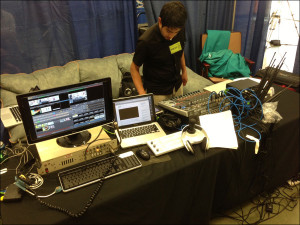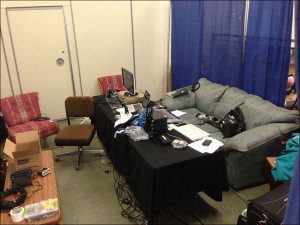A Day at the Missouri State Fair: Master’s Student Shares How KBIA-FM Engaged Listeners in Breaking News Story
By Casey Morell
Master’s Candidate
“So, are you going to Sedalia on Monday?” Intersection’s director Travis McMillen asked me after one show.
“Sedalia? Why are we going to Sedalia?” I responded.
“We’re doing the show from the Missouri State Fair,” he said.
It just so happened that the day we were scheduled to go to the fair was the next Monday. The weekend before the show, there was a somewhat notable incident where a rodeo clown at the fair just so happened to dress as President Barrack Obama.
Let me back up.

Intersection is a weekly hour-long talk show that KBIA-FM produces in conjunction with the Donald W. Reynolds Journalism Institute, and I’m lucky enough to work on the show as a student producer. What’s unique about Intersection is that the show is interactive: I run a chat room during the show where listeners can post their questions and comments to the guests, who then respond to them live. We also film the show in an on-campus studio, and stream the video online. It’s a quirky hybrid radio-television-digital show, but it comes together pretty well.
KBIA is mid Missouri’s NPR affiliate and reaches more than 40,000 listeners in a 70-mile listening area. Students produce stories with audio, video and text for the website while also producing traditional radio newscasts.
Each week, the show has a specific topic – for the show at the fair, the topic was (originally) looking at the history of the fair, and how relevant it was for the future. Before every show, we find relevant guests that we want to talk to, get some brief biographical info on them, and ask them some questions to get background details on the show’s subject.
The rodeo clown incident caused us to change our approach slightly. Although Intersection is a news show, we didn’t want to spend all of our time talking about the clown when it had already been discussed to death by that point; instead, we rearranged our scripts so the clown aspect would take up the first part of the show (about 15 to 20 minutes) and our regular fair coverage would resume from there. We already had booked the president of the fair to appear on the show, and he spoke candidly about what had happened.
During the show, many listeners posted comments about the clown and the fair’s response in our chat room. I forwarded them on to our host, Ryan Famuliner, KBIA’s assistant news director, and he asked them to the fair’s president. That real-time intersection between the listeners and the guests, and how the show becomes a free-flowing discussion about the news of the week, is part of what makes Intersection great, I think.

In order to get the show to Sedalia, though, there was a lot to do. Basically, we had to move an entire TV and radio studio across the state and have it set up in time to do the show…and then break it back down and haul it back to Columbia for the other programs taped at RJI.
Rehman Tungekar, one of KBIA’s producers, and I moved four cameras and their tripods, microphone sets, audio boards, computers, a television switcher, a Comrex box (a neat little thing that sends audio and video over the Internet back to KBIA for broadcast) and countless other equipment with names I could never remember into a university van, and Travis drove us and another student to the fairgrounds to get the studio assembled.
After the show finished, we broke down the studio, loaded it into our van, and spent about an hour roaming around the fairgrounds. While it was a whirlwind of a day, it was a fantastic one – having the opportunity to cover a relatively breaking news story out of nowhere was great experience and a lot of fun.
Plus, I got to go to the Missouri State Fair for the first time.
Casey Morell is a second-year master’s candidate in the Missouri School of Journalism. He graduated from New College of Florida in 2012 with a bachelor degree in liberal arts, focusing in political science and international studies. He has worked with KBIA since arriving at MU in August 2012, and has covered news from local elections to snowstorms – the latter of which can be quite jarring to a native Floridian.
Updated: July 17, 2020